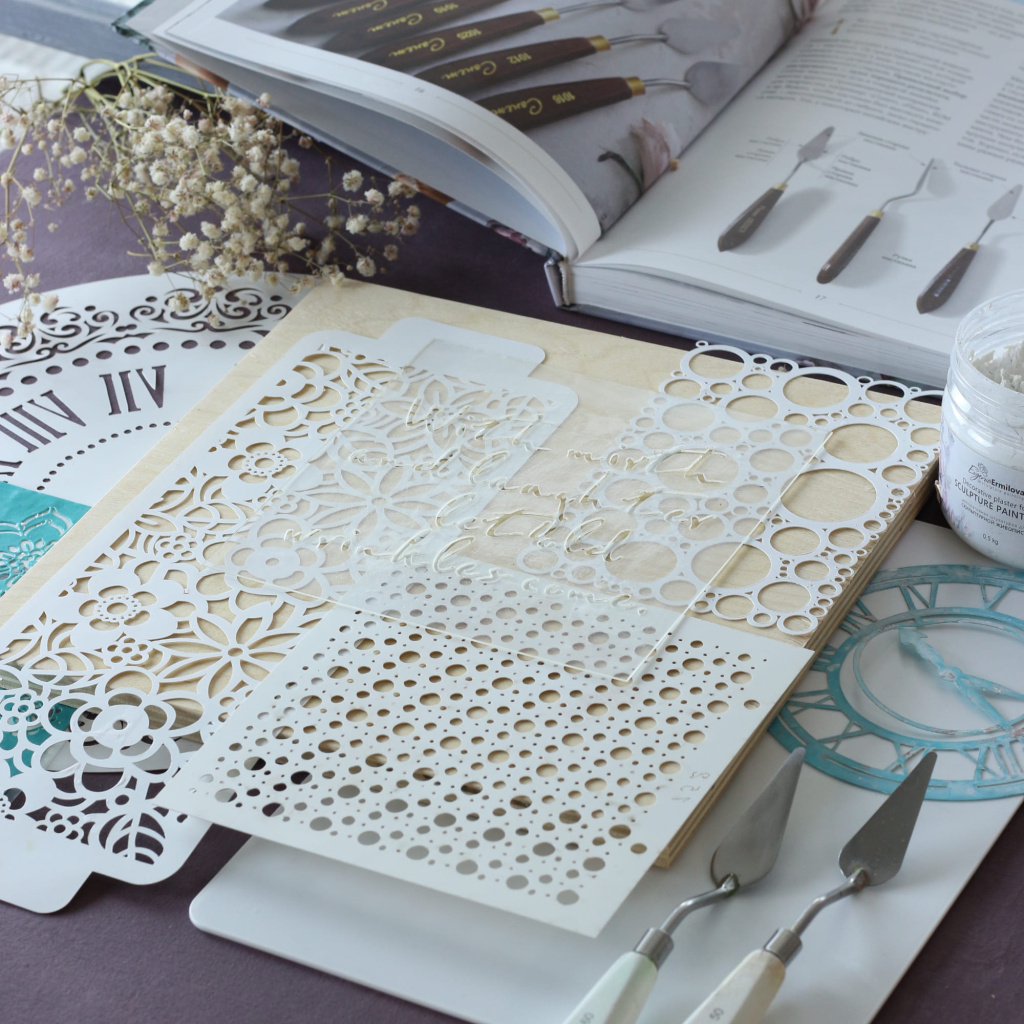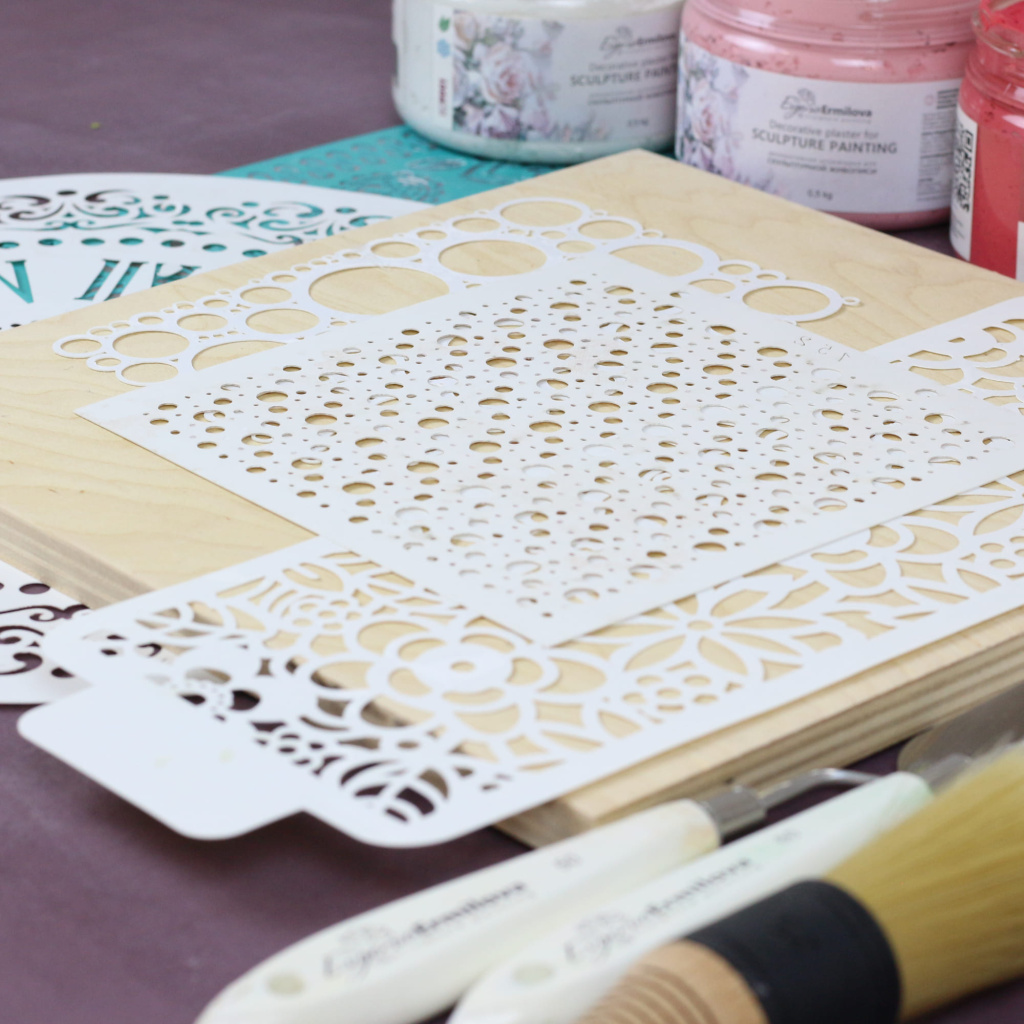Articles about sculpture painting

How to choose a stencil to create a three-dimensional pattern?
Creating a pattern using a stencil is a popular and simple technique that can be used in different areas of creativity. The pattern or pattern can be flat or voluminous, it all depends on the material used. For example, to get a three-dimensional pattern, you need to apply a texture paste through a stencil. And to create a flat drawing, you need to apply paint or ink.
The creation of a three-dimensional pattern is most in demand in the technique of sculptural painting, so we will consider only this further.
So, to create a three-dimensional pattern using a stencil, you will need: a stencil, a palette knife, a texture paste or a paste "Reliefka". You may also need sandpaper to smooth the edges of the ornament.

A three-dimensional pattern through a stencil can be used: when creating panels and paintings, in the decoration of interior clocks, in the decoration of mirror frames and photo frames, in the decoration of furniture and even for wall decoration, in decoupage, in scrapbooking, etc.
The great demand for technology has led to a wide variety of stencils on the market. It is very easy for beginners to get confused. Let's figure it out!
A stencil is a sheet with a pattern, pattern, or design cut out of it. Stencils are made of different materials, different thicknesses, different formats and the thickness of the pattern itself.
The first thing you should start choosing a stencil is to decide on the purpose of use. What is the first thing you want to decorate? Will it be a wall or an album cover? Will it be a small-format painting or a very large one? It depends on what characteristics of the stencil you need to pay attention to.

✅ On the size of the stencil
The larger the stencil, the larger the area can be decorated at a time. Large-format stencils are ideal for the decoration of furniture, walls, the background of large-sized paintings, etc. Small-format stencils are more convenient for the decoration of medium and small-sized paintings, paintings frames, boxes, etc.
The size of the stencil should be written in the product description (when selected in an online store) or on the price tag itself (when selected in an offline store).
✅ On the stencil material and its thickness
Most often, stencils are made of plastic of different thicknesses. The thicker the plastic, the longer the stencil will last. But such stencils bend badly. And sometimes there is a need to create a part of the pattern and you need to bend the stencil. Stencils made of thinner plastic can be bent and patterns can be made in hard-to-reach places.
The thickness and material of the stencil should be written in the product description if you choose in the online store.
✅ On the thickness of the stencil pattern
The thinner the lines of the pattern, the more elegant the pattern created through the stencil will be. But such stencils are more fastidious in care, they are more easily injured. When using a stencil with a very thin pattern, we recommend using a paste "Reliefka". It is more plastic. When using a stencil with a pattern of medium or large size, you can use both "Reliefka" paste and texture paste for sculptural painting in jars.

After creating a pattern using texture or relief paste through a plastic stencil, it should be immediately rinsed with water. If you do not do this immediately, the paste dries on the stencil, and it can quickly become unusable. Life hack! If you cannot interrupt the process during creativity, then soak the used stencil in a container with water (a wide plate, a basin, etc.). So the paste will not dry on it, and you can rinse it when you are free.
The creation of a three-dimensional pattern is most in demand in the technique of sculptural painting, so we will consider only this further.
So, to create a three-dimensional pattern using a stencil, you will need: a stencil, a palette knife, a texture paste or a paste "Reliefka". You may also need sandpaper to smooth the edges of the ornament.

Where is the technique of creating a three-dimensional pattern through a stencil used?
A three-dimensional pattern through a stencil can be used: when creating panels and paintings, in the decoration of interior clocks, in the decoration of mirror frames and photo frames, in the decoration of furniture and even for wall decoration, in decoupage, in scrapbooking, etc.
The great demand for technology has led to a wide variety of stencils on the market. It is very easy for beginners to get confused. Let's figure it out!
A stencil is a sheet with a pattern, pattern, or design cut out of it. Stencils are made of different materials, different thicknesses, different formats and the thickness of the pattern itself.
The first thing you should start choosing a stencil is to decide on the purpose of use. What is the first thing you want to decorate? Will it be a wall or an album cover? Will it be a small-format painting or a very large one? It depends on what characteristics of the stencil you need to pay attention to.

What else should beginners pay attention to when choosing a stencil:
✅ On the size of the stencil
The larger the stencil, the larger the area can be decorated at a time. Large-format stencils are ideal for the decoration of furniture, walls, the background of large-sized paintings, etc. Small-format stencils are more convenient for the decoration of medium and small-sized paintings, paintings frames, boxes, etc.
The size of the stencil should be written in the product description (when selected in an online store) or on the price tag itself (when selected in an offline store).
✅ On the stencil material and its thickness
Most often, stencils are made of plastic of different thicknesses. The thicker the plastic, the longer the stencil will last. But such stencils bend badly. And sometimes there is a need to create a part of the pattern and you need to bend the stencil. Stencils made of thinner plastic can be bent and patterns can be made in hard-to-reach places.
The thickness and material of the stencil should be written in the product description if you choose in the online store.
✅ On the thickness of the stencil pattern
The thinner the lines of the pattern, the more elegant the pattern created through the stencil will be. But such stencils are more fastidious in care, they are more easily injured. When using a stencil with a very thin pattern, we recommend using a paste "Reliefka". It is more plastic. When using a stencil with a pattern of medium or large size, you can use both "Reliefka" paste and texture paste for sculptural painting in jars.

How to take care of stencils?
After creating a pattern using texture or relief paste through a plastic stencil, it should be immediately rinsed with water. If you do not do this immediately, the paste dries on the stencil, and it can quickly become unusable. Life hack! If you cannot interrupt the process during creativity, then soak the used stencil in a container with water (a wide plate, a basin, etc.). So the paste will not dry on it, and you can rinse it when you are free.
11.28.2023

